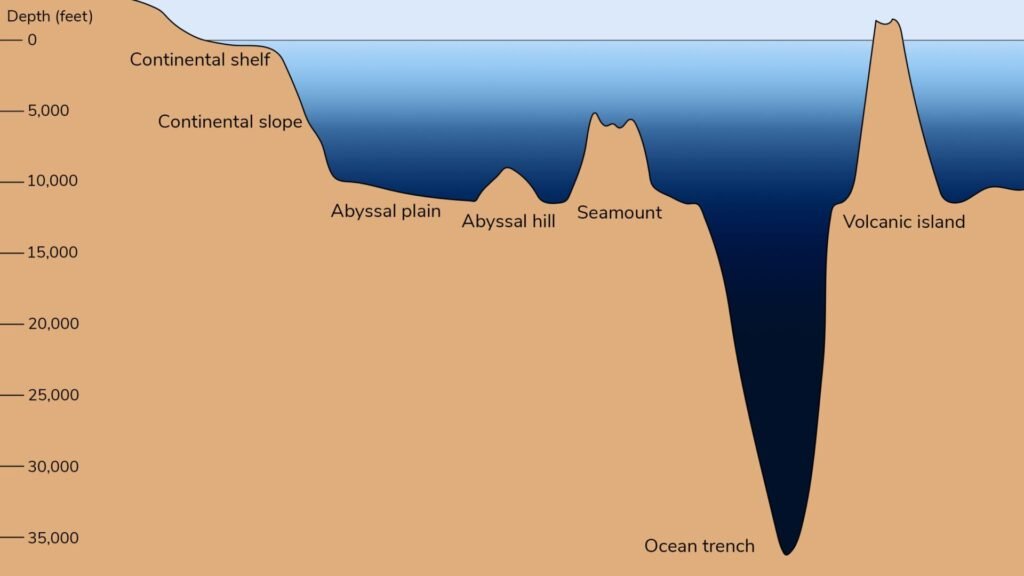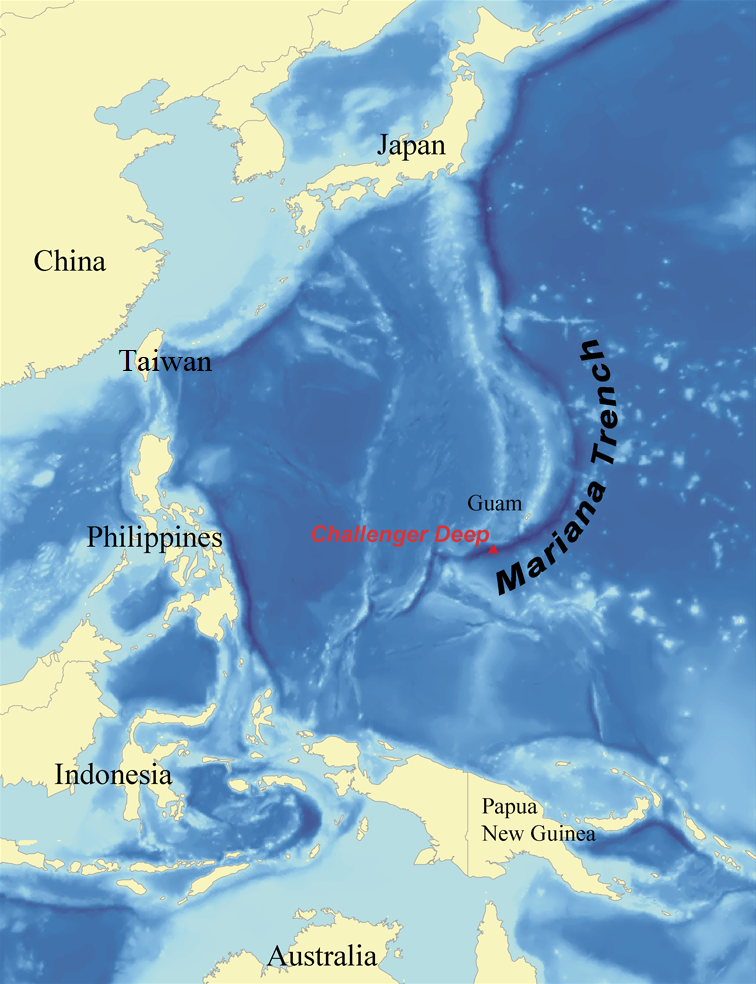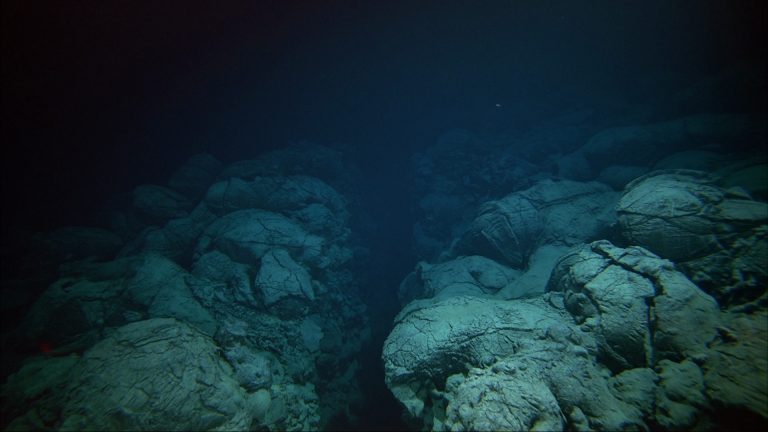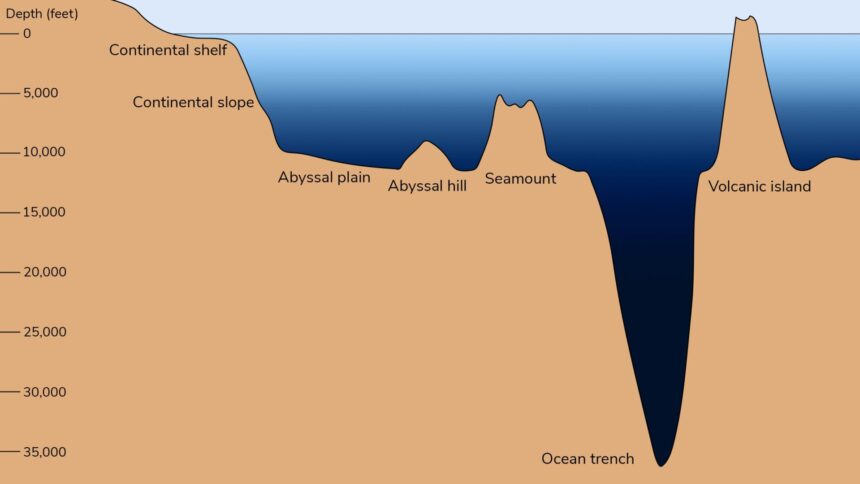Imagine a landscape so vast and unexplored it dwarfs Earth’s continents. Welcome to the ocean relief, a hidden realm shaping our planet.
⫸ Introduction to Ocean Relief
Far from being a featureless expanse, the ocean floor possesses a dramatic topography as diverse and complex as the landscapes we see on land. This is known as ocean relief, encompassing everything from vast plains to towering mountains and the deepest trenches on the planet. Understanding this underwater terrain is key to comprehending the ocean’s complex workings and the wealth of life it supports.
Mid-Ocean Ridge Definition
- Definition: Ocean relief refers to the variations in elevation found on the ocean floor. It includes submerged extensions of continents, enormous mountain ranges, deep canyons, and vast, flat plains.
- Forming Forces: Ocean relief features are primarily shaped by three significant forces:
- Tectonic Activity: The movement of Earth’s plates creates trenches, mountain ranges, and volcanic features.
- Volcanism: Submarine volcanic eruptions can form islands, seamounts, and ridges.
- Sedimentation: The gradual accumulation of sediment can create features like abyssal plains.

The Importance of Understanding Ocean Relief
- Biodiversity: Ocean relief features offer many unique habitats, supporting incredible marine biodiversity. Trenches harbor specialized lifeforms, seamounts become biological hotspots, and canyons provide migration routes.
- Navigation: An accurate understanding of ocean relief is essential for safe and efficient navigation of ships and submarines, preventing groundings and collisions.
- Scientific Study: Studying ocean relief helps us understand:
- Ocean currents and their impact on climate
- Plate tectonics and geological processes
- The potential for marine resources
⫸ Major Ocean Relief Features
The ocean floor reveals a dramatic landscape shaped by powerful forces over millions of years. Here’s a look at its most prominent structures:
Continental Shelf
- Characteristics:
- Gently sloping extension of the continent submerged under relatively shallow water.
- The average depth is around 130 meters.
- Abundant sunlight and nutrients make it biologically rich.
- Formation:
- Formed by the accumulation of sediments from land erosion
- Sea level fluctuations during glacial periods exposed and submerged shelves
Continental Slope
- Characteristics:
- Marks the sharp drop-off from the continental shelf into deeper waters.
- Steeper gradient than the shelf, often dissected by submarine canyons.
- Formation:
- Shaped by tectonic forces and the build-up of sediments from the continental shelf.
Abyssal Plains
- Characteristics:
- Incredibly flat, vast expanses covering much of the deep ocean floor.
- Average depth between 3,000-6,000 meters.
- It is covered by fine sediment layers deposited over time, masking underlying features.
- Formation:
- It is formed by the gradual accumulation of sediment, primarily clay, and silt, carried from continents or biological debris sinking from above.
Ocean Trenches (Oceanic Deeps)
- Characteristics:
- The deepest parts of the ocean – long, narrow, and incredibly deep
- Formed at convergent plate boundaries (subduction zones).
- Host unique ecosystems adapted to extreme pressure and darkness.
- Formation:
- As a result of tectonic plates converging, one plate slides beneath another, creating a deep depression.
- Example: The Mariana Trench

- Mariana Trench is the deepest point in the Earth’s oceans, reaching nearly 11,000 meters (Challenger Deep).
- It is a unique environment with extreme pressures and unusual life forms.
⫸ Minor Ocean Relief Features
While less expansive than the major relief features, minor features add dramatic complexity and diversity to the ocean floor. Let’s explore some of the most fascinating ones:
Ridges and Seamounts:
● Mid-Oceanic Ridges
- Vast, underwater mountain chains formed by tectonic plate divergence.
- A new ocean floor is created along these ridges as magma rises and cools.
- Examples: Mid-Atlantic Ridge, East Pacific Rise

● Seamounts and Guyots
- Seamounts: Isolated volcanic peaks rising from the ocean floor, often formed at hotspots.
- Guyots: Flat-topped seamounts formed when wave action eroded a seamount that reached the surface.
Submarine Canyons:
● Characteristics
- Deep, steep-sided valleys are carved into the continental slopes.
- Can rival land-based canyons in scale (e.g., the Monterey Canyon is comparable to the Grand Canyon).
● Formation
- Curving chains of volcanic islands formed where one tectonic plate subducts beneath another.
- Magma rising from the subducting plate leads to volcanic activity at the surface.
Island Arcs:
● Formation
- Curving chains of volcanic islands formed where one tectonic plate subducts beneath another.
- Magma rising from the subducting plate leads to volcanic activity at the surface.
● Examples
- Aleutian Islands (Alaska)
- Japanese archipelago
- Mariana Islands
⫸ The Dynamic Forces Shaping Ocean Relief
The ocean floor is constantly in flux, molded by powerful natural processes. Key forces that shape and reshape ocean relief include:
Plate Tectonics (Role in Creating Major Features):
- Convergent Boundaries: Where plates collide, subduction zones lead to the formation of oceanic trenches (the deepest parts of the ocean) and volcanic island arcs.
- Divergent Boundaries: Where plates pull apart, mid-ocean ridges form – vast mountain chains created by upwelling magma.
- Transform Boundaries: Where plates slide past each other, fracture zones can occur, creating linear scars on the ocean floor.
Volcanic Activity (Seamounts, Ridges, Islands):
- Seamounts: Underwater volcanoes rising from the ocean floor, some of which may breach the surface as islands.
- Ridges: Large, underwater mountain ranges, particularly the continuous mid-ocean ridges formed at divergent plate boundaries.
- Islands: Volcanic eruptions can create new islands or build upon existing ones, forming archipelagos or larger land masses.
Sedimentation (Formation of Abyssal Plains):
- Accumulation: Fine sediment particles like clay and silt continuously settle on the ocean floor, carried by currents from landmasses and rivers.
- Abyssal Plains: Over immense periods, the build-up of sediment forms vast, flat plains across much of the seafloor, making them one of the most widespread features.
⫸ The Dynamic and Essential Ocean Floor
The ocean floor may seem like a static, unchanging environment, but is in constant flux. Powerful forces like tectonic movement, volcanic activity, and the relentless movement of sediment shape and reshape these underwater landscapes. This dynamic system profoundly influences everything from global currents and climate to the ocean’s rich biodiversity.
Ocean Relief as a Key Component of Earth’s Systems:
- Climate regulator: Ocean relief influences ocean currents, which play a major role in distributing heat around the planet, affecting global weather patterns.
- Carbon sequestration: The ocean floor is a major carbon sink, with sediment and deep-sea ecosystems storing vast amounts of carbon.
- Nutrient cycling: Upwelling and currents driven by ocean relief features transport nutrients, forming the foundation of marine food webs.
Ongoing Exploration and Discovery
- Technological advancements: Sonar, submersibles, and advanced mapping techniques reveal the ocean floor in ever-greater detail.
- Discoveries: Each exploration uncovers novel species and geological formations, expanding our understanding of the ocean’s vastness.
⫸ Conclusion
The ever-changing ocean floor remains a realm of mystery and wonder. As technology advances, our exploration of ocean relief deepens, revealing new secrets about this dynamic environment. These underwater landscapes aren’t simply silent backdrops but integral parts of our planet’s health.
Ocean relief plays a crucial role in supporting marine life and influencing climate. Understanding these features helps us better decide about ocean conservation, resource management, and scientific exploration. The Earth’s hidden depths hold a wealth of knowledge waiting to be uncovered, and understanding ocean relief is our key to doing so.

